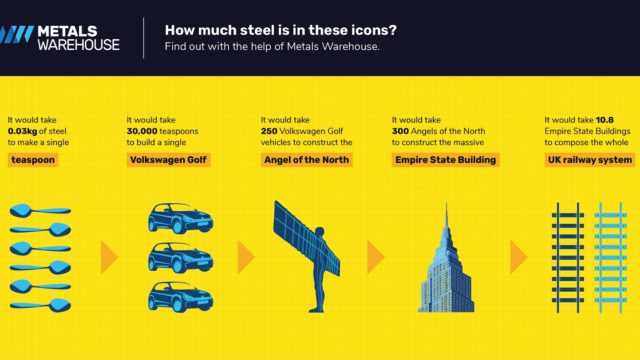
We all love an interesting statistic or fact, don’t we? Or those little golden nuggets of useless information that you say will come in handy in a general knowledge quiz, but never comes to pass.
This next lot of facts will most likely sit within that bracket, but they might just be the most peculiar yet!
Have you ever looked at a structure and wondered: ‘how much stainless steel goes into that?’ Probably not, but we’ve decided to do some digging around, putting into perspective just how much steel goes into some of the world’s biggest structures.
Steel. Items. Structures. The key numbers.
By frantically trawling through the World Wide Web, the company has found out exactly how many kilograms of steel go into an array of different products and structures. These include:
- Teaspoon = 30g
- A golf club = 73g
- A plate of armour = 25kg
- A VW Golf = 787kg
- Angel of the North = 200,000kg
- Forth Rail Bridge = 55kg tonnes
- Empire State Building = 60kg tonnes
- Three Gorges Dam = 463kg tonnes
- The UK railway system = 648kg tonnes

Some of those answers alone are enough to blow your mind, but let’s take that further and spice these facts up!
Sticking with those same kilogram values above, do you think you, your friends, and family would be able to answer how many teaspoons go into the Empire State building off the top of their head? Probably not. Do you think they would know how many golf clubs go into China’s Three Gorges Dam? Again, unlikely.
Well, we have those answers and a few more insane statistics to go alongside them as well! Below are four crazy statistics that might leave your jaw on the floor:
-
- Approximately 2.4 billion teaspoons go into the Empire State Building
- It would take 25,934,400 plates of armour to make up the UK’s entire railway line… to give further context, you could equip an army of 26 million knights with full plate armour with the steel in the UK’s railways
- You would need the equivalent of 634,246,575 golf clubs to build the Three Gorges Dam
- It would require 250 VW Golfs to have enough steel to build your own Angel of the North

From kilograms to kilometres
We’ve also researched how far all the girders that make-up China’s Three Gorges Dam – considered the world’s most powerful power station – would go if you took them out and laid them on the ground.
What is a girder?
Firstly, what is a girder? A girder is typically a large iron or steel beam or compound structure used for constructing bridges and the framework of large buildings and structures. In short, it’s pretty important!
There is approximately 17,301.9432 kilometres worth of girders in the huge structure. To put that into context:
- There are 532km between London and Edinburgh – meaning you would have to travel between the two capitals 33 times (32.52244962 to be precise) to make up the distance of the girders that make up Three Gorges Dam.
- Moving on from that, there are 8,670km between London and Three Gorges Dam – meaning you would have to travel a near round the trip journey (1.995610519 if we’re being picky) to walk, drive, or fly the equivalent length of those girders!
The likelihood is that you didn’t know any of this before reading, but we bet you’re glad you know them now! Who knows, you might just need them someday.
The methodology behind the data
So, how was it done?
We’ve scraped data from a number of websites. A full review of the data can be found by clicking on this link here.
Admittedly, the VW Golf caused an issue. Not a huge one, but an issue nonetheless. For this, the team took the average amount of steel in a car percentage and multiplied it by the weight of a VW Golf – giving the 787kg figure.
Similarly, with the length of girders, Metals Warehouse took the standard size and converted the lb/ft to Kg/m, which gave a figure of 26.7648kg of steel per mile.





